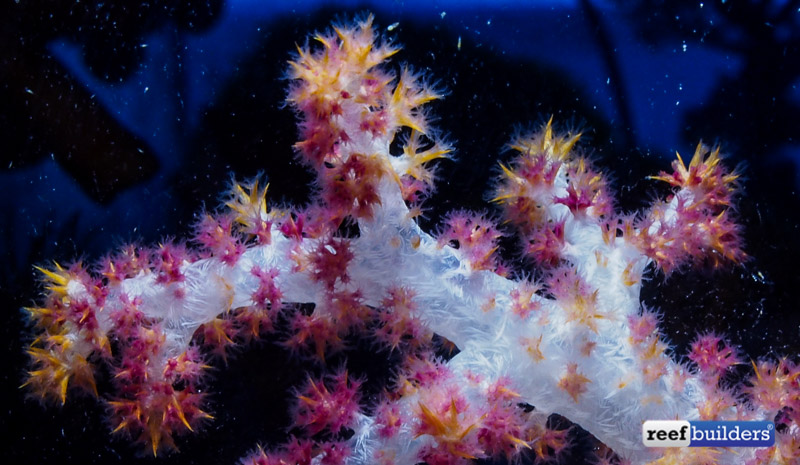Dendronephthya soft corals, better known as ‘carnation corals’, are some of the most beautiful and iconic members of natural reef communities. However, their captive care requirements have remained elusive and to date, no one has really been able to keep and grow Dendronephthya in home aquariums.
Sure, there are the individual reports of ‘some guy your friend knows’ keeping a carnation coral for a year, and maybe even growing it a bit. But by and large, we still haven’t figured out how to truly make these corals happy, within the prescription for a typical home aquarium.

We’ve actively tried to be successful at keeping and growing carnation corals in the past, with limited success, and we closely followed the work of Tim Wijgerde to develop an experimental system specifically for this group of corals. That concerted effort resulted in the eventual loss of all coral colonies within several months despite really trying to provide the Dendronephthya with everything we think that these corals need to be healthy and growing.
Early this summer while in Fiji I selected a single small colony of Dendronephthya from Walt Smith Fiji, mostly on a lark to try and keep alive in an experimental azoox system that I set up at Unique Corals. The experimental aquarium is a 20 gallon long aquarium, set up as a horizontal gyre tank providing constant unidirectional water flow, and it is inline with a 2000 gallon system that houses thousands of SPS coral frags.

I took advantage of the opportunity to concentrate the feeding of azoox corals without having to worry about nutrient build up, since there is a slow flow through of the azoox system water that dispenses all the uneaten coral food to the photosynthetic corals in the system. The single colony of Dendronephthya was placed in this tank as an indicator of feeding enough micro and picoplankton, but I never truly believed that this coral would live so long.
I was so convinced that this coral wouldn’t last, that I didn’t even bother to take a picture of it upon arrival. But now that this coral has been in the tank for more than four months, and looking bigger, brighter and fuller than when it came in, I am kicking myself for not properly documenting this healthy colony of carnation coral.

The puzzling thing about this single observation of a Dendronephthya doing well in captivity is that I can’t point to one single thing that is responsible for this preliminary success. At first I was only feeding about once or twice a week, and tried to wipe down the tank and stir up detritus in a sideways manner of offering some kind of aquarium equivalent of marine snow.
Most Carnation corals don’t outright die, if provided with proper flow and water quality, these corals will generally stay ‘alive’ but all the while degenerating while consuming its own tissue for nutrients. For the first month my sole specimen definitely began to ‘get skinny’, with branches thinning, no signs of growth and a homogenous pink color.

But then in the last six weeks, I’ve been feeding the azoox system a lot more deliberately, and a lot more often. Ever since I’ve definitely observed a much perkier Dendronephthya that has changed from being all pink, to developing small orange branchlets and branch tips over the entire body of the coral.
There’s nothing special or fancy to the food, it is the same basic Reef Builders coral food recipe we wrote about several weeks ago. In that same time period we began doing more target dosing of some supplements in the azoox tank including Nyos Absolute Aminos and Coral Nectar, as well as Prodibio Reef Booster & Coral Vits.

The big difference with this small Azoox system and many others, is that I’ve essentially been feeding and dosing this 20 gallon system with enough additives and food to supplement the 2000 gallon aquarium system. I can’t point to any single one thing that has contributed to this limited success but never having to worry about overdosing or overfeeding certainly doesn’t hurt.
Secondly, there is probably a great deal of benefit that comes from this small experimental tank being inline with a large and healthy reef aquarium system. There’s no telling how much planktonic foods is naturally produced in this combined system so that’s a big ‘black box’ of uncertainty which might be contributing to this moderate success.

At this point the carnation coral is over four months old in captivity, and it is looking healthier and fuller than it ever has. I believe the orange coloration is only present in areas of new growth of this coral, and this colony has changed to become practically half orange. This Dendronephthya was mounted to a magnetic base, and one small branchlet which barely touched the glass before has now grown against the glass and it close to two inches long.
Once again, I am kicking myself because I thought for sure that this coral would be nothing but a memory by now, that I didn’t even bother to take one good snapshot for documentation. I will be scrutinizing and going over all of the methods that are employed on this tank and system to try and duplicate this environment with a greater focus on keeping and growing Dendronephthya in the future.




